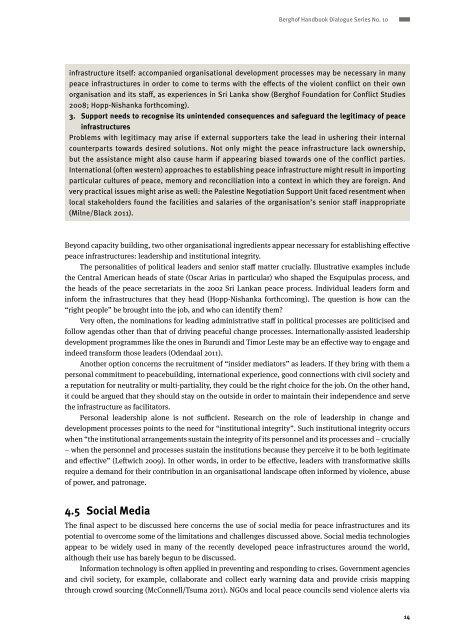Giving Peace an Address? - Berghof Handbook for Conflict ...
Giving Peace an Address? - Berghof Handbook for Conflict ...
Giving Peace an Address? - Berghof Handbook for Conflict ...
You also want an ePaper? Increase the reach of your titles
YUMPU automatically turns print PDFs into web optimized ePapers that Google loves.
<strong>Berghof</strong> H<strong>an</strong>dbook Dialogue Series No. 10<br />
infrastructure itself: accomp<strong>an</strong>ied org<strong>an</strong>isational development processes may be necessary in m<strong>an</strong>y<br />
peace infrastructures in order to come to terms with the effects of the violent conflict on their own<br />
org<strong>an</strong>isation <strong>an</strong>d its staff, as experiences in Sri L<strong>an</strong>ka show (<strong>Berghof</strong> Foundation <strong>for</strong> <strong>Conflict</strong> Studies<br />
2008; Hopp-Nish<strong>an</strong>ka <strong>for</strong>thcoming).<br />
3. Support needs to recognise its unintended consequences <strong>an</strong>d safeguard the legitimacy of peace<br />
infrastructures<br />
Problems with legitimacy may arise if external supporters take the lead in ushering their internal<br />
counterparts towards desired solutions. Not only might the peace infrastructure lack ownership,<br />
but the assist<strong>an</strong>ce might also cause harm if appearing biased towards one of the conflict parties.<br />
International (often western) approaches to establishing peace infrastructure might result in importing<br />
particular cultures of peace, memory <strong>an</strong>d reconciliation into a context in which they are <strong>for</strong>eign. And<br />
very practical issues might arise as well: the Palestine Negotiation Support Unit faced resentment when<br />
local stakeholders found the facilities <strong>an</strong>d salaries of the org<strong>an</strong>isation’s senior staff inappropriate<br />
(Milne/Black 2011).<br />
Beyond capacity building, two other org<strong>an</strong>isational ingredients appear necessary <strong>for</strong> establishing effective<br />
peace infrastructures: leadership <strong>an</strong>d institutional integrity.<br />
The personalities of political leaders <strong>an</strong>d senior staff matter crucially. Illustrative examples include<br />
the Central Americ<strong>an</strong> heads of state (Oscar Arias in particular) who shaped the Esquipulas process, <strong>an</strong>d<br />
the heads of the peace secretariats in the 2002 Sri L<strong>an</strong>k<strong>an</strong> peace process. Individual leaders <strong>for</strong>m <strong>an</strong>d<br />
in<strong>for</strong>m the infrastructures that they head (Hopp-Nish<strong>an</strong>ka <strong>for</strong>thcoming). The question is how c<strong>an</strong> the<br />
“right people” be brought into the job, <strong>an</strong>d who c<strong>an</strong> identify them?<br />
Very often, the nominations <strong>for</strong> leading administrative staff in political processes are politicised <strong>an</strong>d<br />
follow agendas other th<strong>an</strong> that of driving peaceful ch<strong>an</strong>ge processes. Internationally-assisted leadership<br />
development programmes like the ones in Burundi <strong>an</strong>d Timor Leste may be <strong>an</strong> effective way to engage <strong>an</strong>d<br />
indeed tr<strong>an</strong>s<strong>for</strong>m those leaders (Odendaal 2011).<br />
Another option concerns the recruitment of “insider mediators” as leaders. If they bring with them a<br />
personal commitment to peacebuilding, international experience, good connections with civil society <strong>an</strong>d<br />
a reputation <strong>for</strong> neutrality or multi-partiality, they could be the right choice <strong>for</strong> the job. On the other h<strong>an</strong>d,<br />
it could be argued that they should stay on the outside in order to maintain their independence <strong>an</strong>d serve<br />
the infrastructure as facilitators.<br />
Personal leadership alone is not sufficient. Research on the role of leadership in ch<strong>an</strong>ge <strong>an</strong>d<br />
development processes points to the need <strong>for</strong> “institutional integrity”. Such institutional integrity occurs<br />
when “the institutional arr<strong>an</strong>gements sustain the integrity of its personnel <strong>an</strong>d its processes <strong>an</strong>d – crucially<br />
– when the personnel <strong>an</strong>d processes sustain the institutions because they perceive it to be both legitimate<br />
<strong>an</strong>d effective” (Leftwich 2009). In other words, in order to be effective, leaders with tr<strong>an</strong>s<strong>for</strong>mative skills<br />
require a dem<strong>an</strong>d <strong>for</strong> their contribution in <strong>an</strong> org<strong>an</strong>isational l<strong>an</strong>dscape often in<strong>for</strong>med by violence, abuse<br />
of power, <strong>an</strong>d patronage.<br />
4.5 Social Media<br />
The final aspect to be discussed here concerns the use of social media <strong>for</strong> peace infrastructures <strong>an</strong>d its<br />
potential to overcome some of the limitations <strong>an</strong>d challenges discussed above. Social media technologies<br />
appear to be widely used in m<strong>an</strong>y of the recently developed peace infrastructures around the world,<br />
although their use has barely begun to be discussed.<br />
In<strong>for</strong>mation technology is often applied in preventing <strong>an</strong>d responding to crises. Government agencies<br />
<strong>an</strong>d civil society, <strong>for</strong> example, collaborate <strong>an</strong>d collect early warning data <strong>an</strong>d provide crisis mapping<br />
through crowd sourcing (McConnell/Tsuma 2011). NGOs <strong>an</strong>d local peace councils send violence alerts via<br />
14
















